After a landmark court ruling in May cleared the way for Taiwan to become the first Asian country to legalize same-sex marriages, Taipei’s Museum of Contemporary Art (MOCA) is hosting what it claims is the first-ever lesbian, gay, bisexual and transgender (LGBTQ) art exhibition at a public museum in Asia.
Jointly organized by the museum and Hong Kong art promoter Sunpride Foundation, the exhibition, titled Spectrosynthesis? Asian LGBTQ Issues and Art Now, features 51 works by 22 artists from Taiwan, China, Hong Kong, Singapore, the US and Canada.
“The pieces span 50 years and tell the history and life stories of LGBTQ people in the greater Chinese community,” curator Sean Hu (胡朝聖) said on Friday.
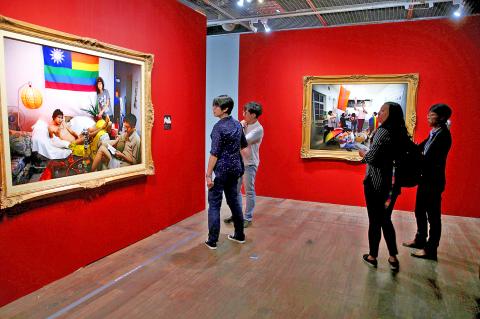
Photo: CNA
The works include paintings, videos, sound recordings, sculptures and photographs, and address a wide range of topics, such as self-identity, social oppression, illness, life and death, as well as desire and lust.
“I hope the exhibition will give the public a chance to communicate different viewpoints and allow visitors to listen to life stories that are different from their own,” Hu said, adding that he hoped the exhibit will help increase public understanding of LGBTQ rights and issues.
Among the works are two oil paintings titled Young Girl (1960) and Male Youth in Yellow Shirt (1967) by late Taiwanese artist Shiy De-jinn (席德進), who was thought to be gay, even though he never publicly came out.
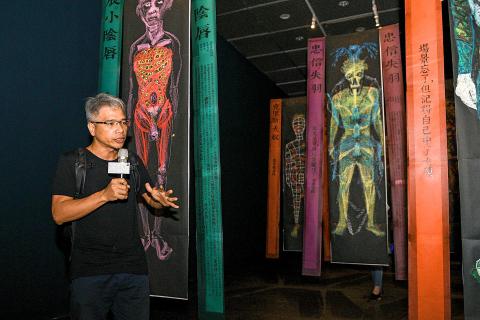
Photo courtesy of the Museum of Contemporary Art
The two iconic paintings are displayed side by side at the beginning of the exhibition to make a statement that “we are all the same, whether we are a girl or a boy,” Hu said.
Chinese artist Xiyadie (西亞蝶) is showcasing colorful paper cuts from his “Door,” “Train” and “Pleasure” series at the exhibition, including the piece Sew Up, which shows a person trapped inside a house and sewing up his penis as the large needle pokes through the roof.
“I want to poke a needle through tradition,” Xiyadie said, adding that he often felt trapped by tradition and the pain made him want to end his life.
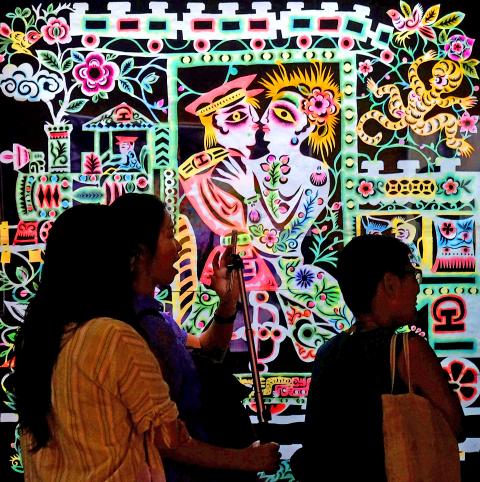
Photo: AFP
Another of his pieces features two men outside a house having sex, while a woman with a baby can be seen inside the house.
Xiyadie, who survived China’s Cultural Revolution, when gay people were severely persecuted, said the autobiographical art mirrors how he feels.
He is happy with his boyfriend, but he is constantly reminded of the pain he caused his wife, the artist said.
Two photographs by Taiwanese artist Tzeng Yi-hsin (曾怡馨), feature people posing as figures from Edouard Manet’s painting Olympia and Eugene Delacroix’s 1830 painting Liberty Leading the People.
“I want to subvert traditional art education that often puts forward a single perspective. The art textbooks that we have read since childhood often feature the views of Western, white, heterosexual men,” she said.
In Tzeng’s photographs, a man poses as the female nude in ?, while members of the Taiwan Alliance to Promote Civil Partnership pose as figures in Delacroix’s painting.
“I want to revisit mainstream artworks from a queer perspective,” said Tzeng, who specializes in mixed media.
Taiwanese artist Wen Hsin (溫馨), who is showcasing four large digital prints from her “Half” series, said her photographs featuring topless people were meant to challenge gender stereotypes and people’s perception of their bodies.
“One of my models was a man who adored his elder sister when he was little. However, past a certain age he was not allowed to imitate his sister’s gestures and voice, and would be mocked by others when he did,” Wen said.
“In the work, he tried to imagine what he would be like today if he had never been wounded in that way and had been allowed to be like his sister,” she said.
Hu said he hoped the exhibition would be able to tour other Asian countries “even though it is difficult.”
He said he is in talks with people in Hong Kong and Thailand about the possibilities.
The exhibition opened yesterday and runs until Nov. 5 at MOCA in Taipei’s Datong District (大同).
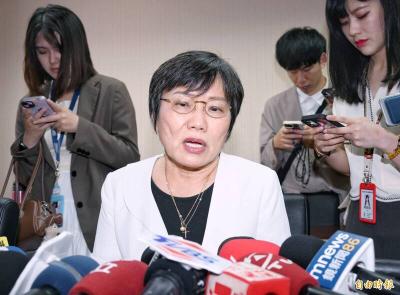
Chinese Nationalist Party (KMT) Chairman Eric Chu (朱立倫), spokeswoman Yang Chih-yu (楊智伃) and Legislator Hsieh Lung-chieh (謝龍介) would be summoned by police for questioning for leading an illegal assembly on Thursday evening last week, Minister of the Interior Liu Shyh-fang (劉世芳) said today. The three KMT officials led an assembly outside the Taipei City Prosecutors’ Office, a restricted area where public assembly is not allowed, protesting the questioning of several KMT staff and searches of KMT headquarters and offices in a recall petition forgery case. Chu, Yang and Hsieh are all suspected of contravening the Assembly and Parade Act (集會遊行法) by holding
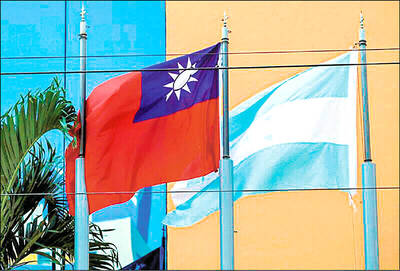
Taiwan would welcome the return of Honduras as a diplomatic ally if its next president decides to make such a move, Minister of Foreign Affairs Lin Chia-lung (林佳龍) said yesterday. “Of course, we would welcome Honduras if they want to restore diplomatic ties with Taiwan after their elections,” Lin said at a meeting of the legislature’s Foreign Affairs and National Defense Committee, when asked to comment on statements made by two of the three Honduran presidential candidates during the presidential campaign in the Central American country. Taiwan is paying close attention to the region as a whole in the wake of a
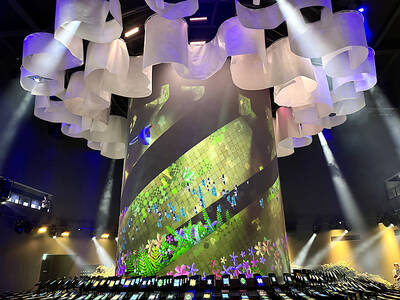
PRAISE: Japanese visitor Takashi Kubota said the Taiwanese temple architecture images showcased in the AI Art Gallery were the most impressive displays he saw Taiwan does not have an official pavilion at the World Expo in Osaka, Japan, because of its diplomatic predicament, but the government-backed Tech World pavilion is drawing interest with its unique recreations of works by Taiwanese artists. The pavilion features an artificial intelligence (AI)-based art gallery showcasing works of famous Taiwanese artists from the Japanese colonial period using innovative technologies. Among its main simulated displays are Eastern gouache paintings by Chen Chin (陳進), Lin Yu-shan (林玉山) and Kuo Hsueh-hu (郭雪湖), who were the three young Taiwanese painters selected for the East Asian Painting exhibition in 1927. Gouache is a water-based

OFF-TARGET: More than 30,000 participants were expected to take part in the Games next month, but only 6,550 foreign and 19,400 Taiwanese athletes have registered Taipei city councilors yesterday blasted the organizers of next month’s World Masters Games over sudden timetable and venue changes, which they said have caused thousands of participants to back out of the international sporting event, among other organizational issues. They also cited visa delays and political interference by China as reasons many foreign athletes are requesting refunds for the event, to be held from May 17 to 30. Jointly organized by the Taipei and New Taipei City governments, the games have been rocked by numerous controversies since preparations began in 2020. Taipei City Councilor Lin Yen-feng (林延鳳) said yesterday that new measures by